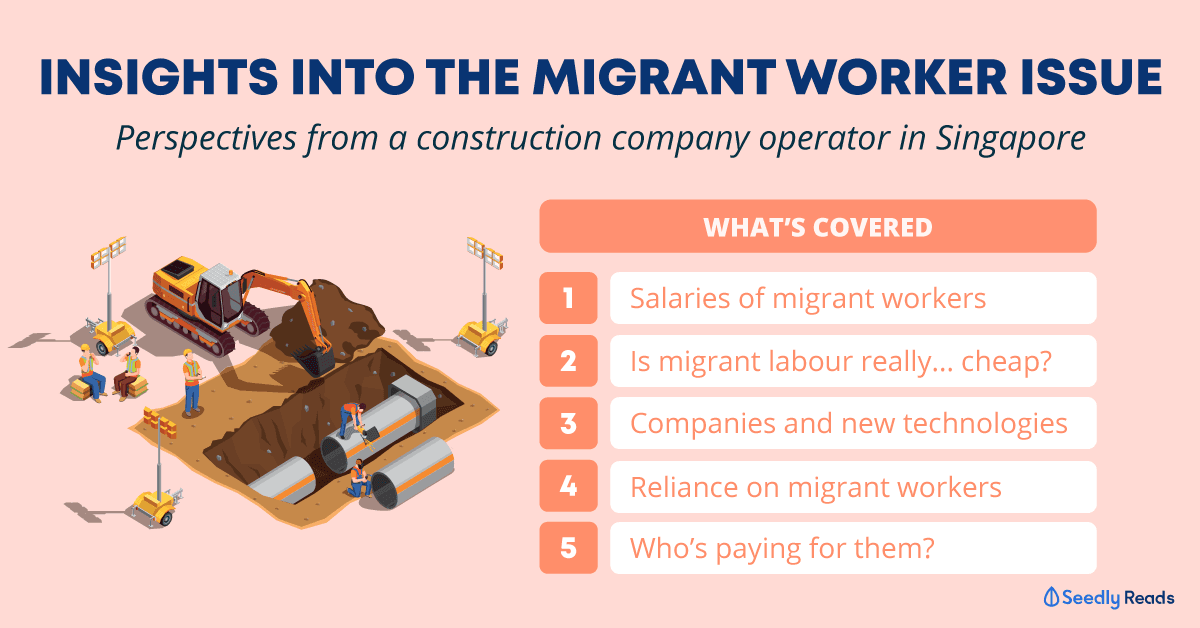After we published our article on the topic of essential workers, a reader of Seedly reached out to us to provide some clarity on the issue of migrant workers.
As we thought that what was presented was very informative and would value-add our readers, we decided to share some points which were brought up by him.
To provide some context, the reader’s father is a Small and Medium Enterprise (SME) construction company operator, and wishes to provide some insights from their point of view.
We wish to share this with our Seedly community, a platform that also always encourages the sharing of opinions and information.
All information is from the point of view of the reader.
Salaries of Migrant Workers

A recent Straits Times article revealed $1200 per month as the median monthly salary for a construction worker.
This is the salary after including overtime (OT) pay.
As with all OT pay, if a worker works more, he will be paid more.
The fixed pay is $18 per day.
This is known as the basic pay, which is what the migrant worker is entitled to every month, even if he does not take any jobs.
The basic sum differs between companies but for the one that my father operates, it is at $400 – $450.
In addition, this is just for newcomers who do not have any experience in the job.
It might then be asked, why are they getting paid so low when the median salary in Singapore is over $4,000?
I would attribute it to the following three reasons:
1. Company Expenses and Worker Expenses

Company expenses are expenses such as levies and housing.
Levies are $950 while dorm rental is at about $350.
These are paid by the company to the government.
Worker expenses are expenses that differ from worker to worker, such as food.
My father’s company also charges for utilities (gas, water, etc.) at $25 per month and lodging at $30 per month ($55 per month in total).
Putting into perspective, an entry-level worker earns $1,200 while only spending on food and $55 per month.
All these while having a shelter with proper access to electricity, water, and transport.
A university intern would earn roughly $1,500 but have to spend on utilities, food, transport, and maybe even rental.
2. Not Earning to Live in Singapore

Most migrant workers do not work so that they can spend their money in Singapore, unlike most of us where this is home.
Taking Dhaka (capital of Bangladesh) as an example, the living wage there is US$214 but they are earning US$860 for working in Singapore.
That is a 4x increase for coming to work in Singapore.
This significantly increases their spending power in the future as the money should be converted to that in their home country.
As a fun fact, when my father’s longest-serving worker retired, he had bought a 3-story mansion in Bangladesh with his own maids and helpers.
3. Education Level

It is no secret that construction workers do not require a high level of education.
However, when we look at a Bengali doctor, who has worked hard and spent money to enroll in medical school, he earns an average salary of US$1,559.
A migrant worker with no education earns US$860.
This means that if you go to school, work hard and spend money on education, an average Bengali doctor only earns 1.8x more than a migrant worker who did not go through that process.
Not Cheap to Hire Migrant Labour

One worker’s cost is not just his pay.
With levies and housing, this brings an average worker’s cost to $2,500, along with miscellaneous costs and additional risks such as Ministry of Manpower (MOM) complaints, injuries, loans, and medicals.
It is NOT cheap to hire migrant workers.
Using a project with 50 workers as an example, this would cost at least $125,000 per month.
In addition, this sum has to be paid by the subcontractor (my father) to the workers even before receiving any revenue from the general contractor/ government body/ developer that hired him.
Essentially, using more workers means more debt for my family since subcontractors (mostly) do not receive their due share in due time.
Not True That Companies Do Not Want to Invest In New Technology
It is not that companies do not want to invest in new technology that can ease the migrant workers’ workload.
Having an automated work process would be great since it eliminates human problems such as needs, emotions, fatigue, and illnesses.
The reason for not investing in new technology stems from two reasons:
1. High Cost for Uncertain Results
Research and Development (R&D) is expensive and with the technology being still relatively unexplored, developing new technology carries a very high risk for very uncertain rewards.
2. Insufficient Expertise

Most people in construction don’t understand technology.
A week ago, my dad didn’t even understand that different accounts require different passwords despite having the same email.
Construction companies are mostly run by people in their 40s or 50s who don’t have expertise in technology.
Asking them to develop R&D in technology is an alien concept to them and will not work since they don’t have basic technological knowledge.
The previous article mentioned the following:
Government intervenes (probably by increasing cost of foreign workers) > Companies would want to reduce cost > Companies invest in technology
However, this is my alternate scenario:
Government intervenes (probably by increasing cost of foreign workers) > Big companies invest in technology and treats these as trade secrets (at the same time, small companies pay for these additional costs as they don’t have R&D) > Big companies solve the problem for themselves while SMEs take on more costs
Sustainability of Reliance on Migrant Workers

I agree that it is unsustainable to rely on migrant workers, but only to a certain extent.
In a situation where there is a pandemic which meant no travel and no workers, there will also be no jobs so there is no need to hire new workers anyway.
In addition, there is a possibility where countries develop, and there will come a day where there are no workers.
That day may come but I believe that this is still a very long process that is not attainable in the next 20 years.
In addition, many external factors will stop said country from reaching that stage of development.
It will only take one war or plague to set back this progress by years.
Nevertheless, I still agree that if we fully rely on migrant workers for everything, it is unsustainable for the nation.
However, as it stands, I do not have any sort of solution and believe the status quo is better.
Who’s Paying for Migrant Workers

In the recent survey by Milieu, it says that Singaporeans are willing to pay up to 20% more if these amounts went to workers.
However, I think we have to keep in mind that these people may not have a full understanding of the situation and could probably just be responding as they were presented with numbers and a hypothetical.
Some of them would probably choose differently when it comes time to pay.
This also begs the question – who’s paying for the 20%?

General population pay:
The general population could make up the extra difference. That would be an additional $240 million in taxes for the general population to carry.

Companies pay:
As mentioned, companies currently pay $2,500 per worker.
If companies were to take on this burden, how much more should a foreign worker cost?
It should also be kept in mind that to make a profit, companies will have to earn more than $2,500 per worker in terms of the work they do.
So raising it to too high a number essentially means working the workers to past their point of fatigue, which is extremely dangerous.

Government pay:
I see this as the most effective method.
For the government to reduce the cost of levies and housing and put the difference into raising the workers’ pay (should that be the objective).
You may know that with the COVID-19 pandemic, the government gives a $750 payout to companies per foreign workers and this is the “handout” mentioned.
However, $350 of this $750 goes to dorm rents (government’s pocket) and $400 has to be given to the workers as this is their basic pay ($18 per day).
Yes, according to MOM law, even though there’s no work to be done, the companies still have to pay the foreign workers their basic pay.
This handout disregards the fact that companies still have to pay office rental, COE, other staff, and have a family to feed.
It also forgets that companies are not earning any money in the meantime.
Conclusion
Overall, I do stand by that migrant workers’ quality of life should be improved, however, I feel that there is often too much responsibility placed on the shoulders of companies to do so.
Everyone seems to have the misconception that construction company bosses are rich people and wonder why can’t they just pay the workers a little more.
I think it needs to be seen that SME construction company operators (like my dad and many others) are just average people trying to provide for their families and it should be the responsibility of the government to make things better.
